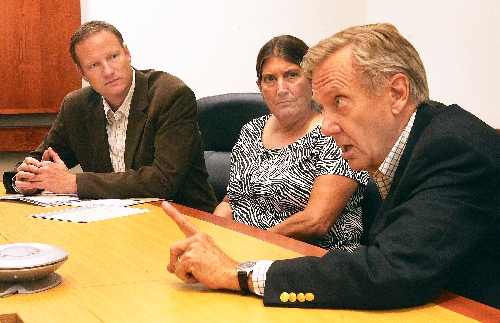Energy projects raise concerns

With solar and wind energy projects targeting vast areas of the West, protectors of some 27 million acres known as National Conservation Lands will try to craft policy changes this weekend for preserving the wild integrity of those lands for future generations.
Calling the gathering at the J.W. Marriott the “Friends Rendezvous,” the meeting of the Friends of Red Rock Canyon, Friends of Sloan Canyon, Friends of Gold Butte and others is a prelude to Monday’s summit of federal managers who are steering the course for land users to follow.
Leading the charge on the environmental front is the Colorado-based Conservation Lands Foundation and its advocate, Bruce Babbitt, who served as Interior secretary under President Bill Clinton.
He acknowledged that the task will be challenging to proceed with renewable energy development while at the same time preserving wildlife habitat, American Indian cultural sites and landscape views. But he said he believes it can be accomplished only with Bureau of Land Management playing a pivotal role.
The agency, however, needs better policies to ensure that some 800 sites including national monuments, parks and conservation areas can coexist with renewable energy development.
“The important thing is to have good front-end land use planning,” Babbitt said during an interview Thursday at the Review-Journal. “It’s not about kicking everybody off the land. It’s about protecting traditional uses of the land. And it’s not about building all of the infrastructure that comes with a national park. It’s about getting the community behind it and protecting traditional uses.”
Brian O’Donnell, executive director of the Conservation Lands Foundation, said the window to protect these areas is closing fast.
“These places are what makes the West the West,” he said. “It’s our history; it’s our heritage as a nation. We want to make sure that our kids and future generations can experience some of these unspoiled natural areas the same way we have.”
O’Donnell said the public can’t just assume that wildlands and the resources on them — American Indian rock art, sensitive plants and animals, and untarnished landscapes — will be around forever.
“That’s a dangerous assumption,” he said. “If we don’t actively work to ensure that some of these areas are safeguarded then we’re going to lose them.”
Babbitt said the best way to protect public lands, based on his experience with national monuments in Southern Utah, is to get local communities involved.
“I spend a lot of time tramping around the West meeting with local groups and talking about the importance of getting this BLM conservation mission really embedded in the cultural and political matrix of the West,” he said.
Among the best examples to follow in Southern Nevada, he said, is Nancy Hall, a Mesquite resident who is president of Friends of Gold Butte.
Hall devotes countless volunteer hours as a steward of Gold Butte, a sprawling natural area some 60 miles northeast of the Las Vegas Valley.
“The land belongs to us and we need to care of it. It belongs to everyone,” she said.
But what’s needed, other than protecting it through presidential designation as a national monument or legislation for a national conservation area, is a visitor center in Mesquite, she said.
“The idea of having this visitor center in town brings the community together to take care of the area,” she said.
Said Babbitt: “Since Las Vegas is the gateway to the Grand Canyon, it’s really important for Las Vegas to have a piece of the Grand Canyon landscape under protection.”
On the solar energy front, he said there are lots of potential solar sites.
“What the BLM needs to do, and is starting to do, is lay out a plan, find the solar sites where there are minimum conflicts with access to transmission lines and good site and then draw a big map and say, ‘Ya’ll come.’ They’re moving in that direction but it’s happening slowly.”
As for rows of towering windmills lining ridges in east-central Nevada, Babbitt said it might take some creative thinking to install them by using helicopters, for example, instead of marring the landscape with a system of roads for one purpose.
Despite the image they conjure and potential impact on birds and migratory bat populations, he believes wind farms can fit in the environment.
One thought comes to mind, he said.
“When I see those wind turbines on the horizon I think that should you go to an art gallery in New York you will see people paying millions of dollars for Dutch paintings of windmills on the landscape.”
Contact reporter Keith Rogers at krogers@reviewjournal.com or 702-383-0308.












